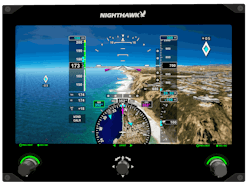Nighthawk unveils Guardian glass cockpit system for general aviation
Questions and answers:
- What is the Nighthawk Guardian avionics system?
The Guardian is a glass cockpit avionics system developed by Nighthawk Flight Systems for general aviation aircraft. It features modular components, high-resolution 3D synthetic vision, and integrates with existing avionics. - How does the Guardian system compare to other glass cockpits?
Guardian is up to 50% lighter than comparable systems and allows for individual upgrades without replacing the entire unit. It uses a modular architecture that simplifies integration and reduces long-term costs.
OSHKOSH, Wis. - Nighthawk Flight Systems, Inc., in Vista, Calif., has introduced its new Guardian large-format glass cockpit avionics system, aiming to provide general aviation pilots with a lighter, customizable alternative to traditional avionics suites.
The system, revealed at EAA AirVenture Oshkosh 2025, is designed to integrate with existing cockpit equipment and improve situational awareness through enhanced 3D graphics and synthetic vision. According to the company, Guardian consolidates traffic, terrain, weather, obstacle, and satellite imagery data into a single high-resolution, real-world view displayed on one or more touchscreen panels.
"We developed Guardian to give general aviation aircraft an affordable system with all the functions and features of advanced glass systems, but better. We provide a much lighter, more affordable system with the best, most realistic synthetic vision on the market," said Nighthawk CEO Paul Martin. "We offer general aviation pilots, owners, and operators a far superior fully customizable glass cockpit, with unmatched simulated vision. We use 'Smart I/O' to operate seamlessly with existing systems and sensors, on a single or multiple touchscreen displays."
NEST
At the core of the system is a compact processing unit called the NEST, which connects to the displays through a single cable and contains modular components or "blades." These blades provide mission computing, air data, and attitude sensing, as well as smart I/O capabilities. The smart I/O component interfaces with existing onboard systems such as GPS, radios, autopilot, ADS-B In, and weather sensors.
Weighing up to 50 percent less than comparable systems, Guardian is designed for flexibility. Aircraft owners can add or upgrade capabilities by swapping out individual blades, reducing the need for full-system replacements. Display units can also be replaced independently.
